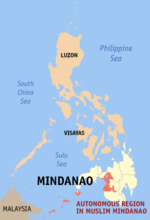Autonomous regions of the Philippines
 |
| This article is part of a series on the politics and government of the Philippines |
|
|
Politics portal |
An autonomous region (Filipino: ''Nagsasarili na mga rehiyon ng Pilipinas'') is a first-level Administrative divisions of the Philippines. an autonomous region has its own local government has more legislative rights. An autonomous region is a minority entity which has a higher population of a particular minority ethnic group. The constitution of the Philippines allows for two autonomous regions: one each for the Cordilleras and Muslim Mindanao. [1]
The Autonomous Region in Muslim Mindanao was founded in 1976 during Marcos administration and region was first created on August 1, 1989 through Republic Act No. 6734 (otherwise known as the Organic Act) in pursuance with a constitutional mandate to provide for an autonomous area in Muslim Mindanao. Later In year 2012 the president described the ARMM was "failed experiment" after that they plan to established the autonomous region in the Philippines (named Bangsamoro) to replace ARMM with the agreement between the government and Moro Islamic Liberation Front.
Two plebiscites were conducted to effectively establish an autonomous region in the Cordilleras during the 1990s. Both plebiscites failed, thus Cordillera Administrative Region remains a regular administrative region.
List of autonomous regions
Current
| Autonomous region | Founded | Administration | Leader | Map (loacation) |
|---|---|---|---|---|
| Autonomous Region in Muslim Mindanao | 1976 | The Autonomous Region of Muslim Mindanao region was first created on August 1, 1989 through Republic Act No. 6734 (otherwise known as the Organic Act) in pursuance with a constitutional mandate to provide for an autonomous area in Muslim Mindanao. A plebiscite was held in the provinces of Basilan, Cotabato, Davao del Norte, Davao Oriental, Davao del Sur, Lanao del Norte, Lanao del Sur, Maguindanao, Palawan, South Cotabato, Sultan Kudarat, Sulu, Tawi-Tawi, Zamboanga del Norte and Zamboanga del Sur; and in the cities of Cotabato, Davao, Dapitan, Dipolog, General Santos, Koronadal, Iligan, Marawi, Pagadian, Puerto Princesa and Zamboanga to determine if their residents wished to be part of the ARMM. Of these areas, only four provinces - Lanao del Sur, Maguindanao, Sulu and Tawi-Tawi - voted in favor of inclusion in the new autonomous region. The ARMM was officially inaugurated on November 6, 1990 in Cotabato City, which was designated as its provincional capital.[2] | Mujiv S. Hataman |  |
Proposed
| Autonomous region | Founded (Planned) | Administration | Map (loacation) |
|---|---|---|---|
| Bangsamoro | Before 2016 | On October 15, 2012,[3] the historic preliminary agreement was signed by Government's chief negotiator Marvic Leonen, MILF Peace Panel Chair Mohagher Iqbal, and Malaysian facilitator Tengku Dato’ Ab Ghafar Tengku Mohamed along with President Aquino, Prime Minister Najib Razak of Malaysia, Chairman Al-Hajj Murad Ebrahim of the MILF, and Secretary-General Ekmeleddin İhsanoğlu of the Organisation of Islamic Cooperation at the Malacañang Palace in Manila.[4] [5]This document outlines general agreements on major issues, including the extent of power, revenues and territory granted for the new Muslim autonomous region.[6] |  |
| Cordillera Autonomous Region | N/A | There has been calls to replace establish an autonomous region to replace the Cordillera Administrative Region through the refiling of House Bill 5595 which seeks to address such calls.[7] | |
See also
References
- ↑
- ↑ The ARMM will replace by the governement
- ↑ "Gov’t, MILF Agree to Create Bangsamoro to Replace ARMM". October 15, 2012. Retrieved 2012-10-15.
- ↑ Framework Agreement of the Bangsamoro. Government of the Philippines. October 20, 2012.
- ↑ "Gov’t, MILF seal preliminary peace pact". October 15, 2012. Retrieved 2012-10-15.
- ↑
- ↑ "Cordillera Solons expressed views on regional autonomy". National Economic and Development Authority - Cordillera Administrative Region. 12 August 2013. Retrieved 28 February 2015.
| ||||||||||||||
| |||||||||||||||||||||||||||||||||||||||||||||
